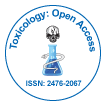Cardiac Toxicology: Understanding the Heart's Vulnerability to Toxic Substances
Received: 01-May-2024 / Manuscript No. tyoa-24-139156 / Editor assigned: 03-May-2024 / PreQC No. tyoa-24-139156 (PQ) / Reviewed: 17-May-2024 / QC No. tyoa-24-139156 / Revised: 20-May-2024 / Manuscript No. tyoa-24-139156 (R) / Published Date: 27-May-2024
Abstract
Cardiac toxicology, a critical branch of medical science, delves into the effects of toxic substances on the heart. The heart, a vital organ responsible for pumping blood throughout the body, is particularly susceptible to a variety of toxins. These toxic agents can cause acute or chronic damage, leading to severe cardiovascular conditions, including arrhythmias, cardiomyopathy, and heart failure
keywords
Cardiac toxicity; Blood; Toxins
Introduction
The mechanisms through which toxins affect the heart are diverse and complex. Some common pathways include direct damage to cardiac cells, disruption of ion channels, oxidative stress, and interference with mitochondrial function [1,2].
Methodology
Certain toxins can cause direct injury to cardiomyocytes, the muscle cells of the heart. For instance, doxorubicin, a chemotherapy drug, induces apoptosis (programmed cell death) in these cells, leading to cardiotoxicity.
The proper function of ion channels is crucial for maintaining the heart's rhythm. Toxins such as those from scorpion venom or certain medications can block or alter the function of these channels, leading to arrhythmias.
Many toxins increase the production of reactive oxygen species (ROS), which damage cellular components through oxidative stress. This mechanism is seen in alcohol-induced cardiomyopathy, where chronic alcohol consumption leads to increased ROS, damaging heart tissue.
Mitochondria are essential for energy production in cells. Toxins like carbon monoxide inhibit mitochondrial respiration, leading to energy depletion and cellular damage in the heart [3-6].
Common cardiotoxic agents
A wide range of substances can be cardiotoxic, including certain drugs, environmental toxins, and natural compounds.
Many drugs, while beneficial for treating specific conditions, can have unintended cardiotoxic effects. Chemotherapeutic agents like doxorubicin and trastuzumab are well-known for their potential to cause cardiomyopathy. Additionally, some antipsychotics and antidepressants can lead to arrhythmias.
Exposure to pollutants such as carbon monoxide, heavy metals (e.g., lead, mercury), and pesticides can adversely affect the heart. Chronic exposure to air pollution has been linked to increased risks of hypertension, atherosclerosis, and heart failure.
Venoms from snakes, scorpions, and certain marine animals contain potent toxins that can disrupt cardiac function. Additionally, some plant-based substances, such as those found in foxglove (Digitalis), can cause severe cardiac disturbances.
The clinical manifestations of cardiac toxicity can vary widely, ranging from asymptomatic changes in cardiac biomarkers to severe, life-threatening conditions. Common symptoms include chest pain, palpitations, shortness of breath, and syncope [7-9].
Diagnosing cardiac toxicity involves a combination of patient history, physical examination, and various diagnostic tests. Electrocardiograms (ECGs) are crucial for detecting arrhythmias, while echocardiography can assess structural and functional changes in the heart. Biomarkers like troponins and B-type natriuretic peptide (BNP) are also valuable in identifying myocardial injury and heart failure.
Prevention and management
Preventing and managing cardiac toxicity requires a multifaceted approach. For drug-induced toxicity, careful monitoring and dose adjustments can mitigate risks. In cases of environmental toxin exposure, reducing exposure and using protective measures are essential.
Treatment strategies for cardiac toxicity may include the use of antidotes (e.g., digoxin-specific antibody fragments for digoxin toxicity), symptomatic management with medications such as beta-blockers or antiarrhythmics, and supportive care, including oxygen therapy and mechanical ventilation in severe cases [10].
Conclusion
Cardiac toxicology is a vital field that addresses the heart's vulnerability to a wide array of toxic substances. Understanding the mechanisms, identifying the sources of toxicity, and implementing effective prevention and management strategies are crucial for safeguarding cardiac health. Continued research and education in this field are essential to mitigate the risks and improve outcomes for individuals exposed to cardiotoxic agents.
References
- Jurate V, Mika S, Petri L (2002) Electrokinetic soil remediation--critical overview. Sci Total Environ 289: 97-121.
- Zhiping S, Hui Z, Yunhong Z (2010) Polyimides: Promising energy-storage materials. Angew Chem Int Ed 49: 8444-8448.
- Cavallaro G, Lazzara G, Milioto S (2010) Dispersions of Nanoclays of Different Shapes into Aqueous and Solid Biopolymeric Matrices. Extended Physicochemical Study. J Surf Colloids 27: 1158-1167.
- Lee J, Cameron I, Hassall M (2019) Improving process safety: what roles for digitalization and industry 4.0? Process Saf Environ Prot 132: 325-339.
- Baraud F, Tellier S, Astruc M (1997) Ion velocity in soil solution during electrokinetic remediation. J. Hazard Mater 56: 315-332.
- Ji H, Huang W, Xing Z, Zuo J, Wang Z, et al. (2019) Experimental study on removing heavy metals from the municipal solid waste incineration fly ash with the modified electrokinetic remediation device. Sci Rep 9: 8271.
- Le Borgne S, Paniagua D, Vazquez-Duhalt R (2008) Biodegradation of organic pollutants by halophilic Bacteria and Archaea. J Mol Microbiol Biotechnol 15: 74-92.
- Agamuthu P, Abioye OP, Aziz AA (2010) Phytoremediation of soil contaminated with used lubricating oil using Jatropha curcas. J Hazard Mater 179: 891-894.
- Bergerson JA, Keith D (2010) The truth about dirty oil: is CCS the answer? Environ Sci Technol 44: 6010-6015.
- Carlson HK, Stoeva MK, Justice NB, Sczesnak A, Mullan MR, et al. (2015) Monofluorophosphate is a selective inhibitor of respiratory sulfate‐reducing microorganisms. Environ Sci Technol 49: 3727-3736.
Indexed at, Google Scholar, Crossref
Indexed at, Google Scholar, Crossref
Indexed at, Google Scholar, Crossref
Indexed at, Google Scholar, Crossref
Indexed at, Google Scholar, Crossref
Indexed at, Google Scholar, Crossref
Indexed at, Google Scholar, Crossref
Indexed at, Google Scholar, Crossref
Citation: Saima Z (2024) Cardiac Toxicology: Understanding the Heart'sVulnerability to Toxic Substances. Toxicol Open Access 10: 276.
Copyright: © 2024 Saima Z. This is an open-access article distributed under theterms of the Creative Commons Attribution License, which permits unrestricteduse, distribution, and reproduction in any medium, provided the original author andsource are credited.
Share This Article
Open Access Journals
Article Usage
- Total views: 395
- [From(publication date): 0-2024 - Apr 02, 2025]
- Breakdown by view type
- HTML page views: 207
- PDF downloads: 188
